Electrical Percolation Threshold and Size Effects in Polyvinylpyrrolidone-Oxidized Single-Wall Carbon Nanohorn Nanocomposite: The Impact for Relative Humidity Resistive Sensors Design
Abstract
:1. Introduction
2. Materials and Methods
3. Results
3.1. Morphological and Compositional Characterization of the CNHox and PVP Nanocomposite
3.2. Determination of Electrical Percolation Threshold ψc for CNHox–PVP Films Deposited on a Rigid Substrate
3.3. Determination of Electrical Percolation Threshold ψc for Oxidized Carbon Nanohorns–PVP Films Deposited on a Flexible Substrate
4. Discussion
- A.
- The elastic module of the carbon nanohorns.
- B.
- The elastic module of the polymer (PVP) matrix.
- C.
- Finally, we will assume that the conversion between the concentration (at threshold), which is expressed in weight %, and the volume % associated with a particular filler concentration, is used in [1], i.e., vol% = wt% for single-wall nanotubes.
5. Conclusions
Author Contributions
Funding
Institutional Review Board Statement
Informed Consent Statement
Data Availability Statement
Acknowledgments
Conflicts of Interest
References
- Bauhofer, W.; Kovacs, J.Z. A review and analysis of electrical percolation in carbon nanotube polymer composites. Compos. Sci. Technol. 2009, 69, 1486–1498. [Google Scholar] [CrossRef]
- Khan, W.S.; Asmatulu, R.; Eltabey, M.M. Electrical and thermal characterization of electrospun PVP nanocomposite fibers. J. Nanomater. 2013, 2013, 1–9. [Google Scholar] [CrossRef]
- Kovacs, J.Z.; Velagala, B.S.; Schulte, K.; Bauhofer, W. Two percolation thresholds in carbon nanotube epoxy composites. Compos. Sci. Technol. 2007, 67, 922–928. [Google Scholar] [CrossRef] [Green Version]
- Sandler, J.; Kirk, J.E.; Kinloch, I.A.; Shaffer, M.; Windle, A.H. Ultra-low electrical percolation threshold in carbon-nanotube-epoxy composites. Polymer 2003, 44, 5893–5899. [Google Scholar] [CrossRef]
- Lu, C.; Mai, Y.W. Anomalous electrical conductivity and percolation in carbon nanotube composites. J. Mater. Sci. 2008, 43, 6012–6015. [Google Scholar] [CrossRef]
- Kim, B.J.; Lee, I.Y. Electrical properties of single-wall carbon nanotube and epoxy composites. J. App. Phys. 2003, 94, 6724–6728. [Google Scholar] [CrossRef]
- Li, J.; Ma, P.C.; Chow, W.S.; To, C.K.; Tang, B.Z.; Kim, J.-K. Correlations between percolation threshold, dispersion state, and aspect ratio of carbon nanotubes. Adv. Funct. Mater. 2007, 17, 3207–3215. [Google Scholar] [CrossRef]
- Antonucci, V.; Faiella, G.; Giordano, M.; Nicolais, L.; Pepe, G. Electrical properties of single walled carbon nanotube reinforced polystyrene composites. Macromol. Symp. 2007, 247, 172–181. [Google Scholar] [CrossRef]
- Ramasubramaniam, R.; Chen, J.; Liu, H. Homogeneous carbon nanotube/polymer composites for electrical applications. Appl. Phys. Lett. 2003, 83, 2928–2930. [Google Scholar] [CrossRef]
- Nogales, A.; Broza, G.; Roslaniec, Z.; Schulte, K.; Šics, I.; Hsiao, B.S.; Ezquerra, T.A. Low percolation threshold in nanocomposites based on oxidized single wall carbon nanotubes and poly (butylene terephthalate). Macromolecules 2004, 37, 7669–7672. [Google Scholar] [CrossRef]
- Dang, Z.-M.; Shehzad, K.; Zha, J.-W.; Mujahid, A.; Hussain, T.; Nie, J.; Shi, C.-Y. Complementary percolation characteristics of carbon fillers based electrically percolative thermoplastic elastomer composites. Compos. Sci. Technol. 2011, 72, 28–35. [Google Scholar] [CrossRef]
- Pandis, C.; Peoglos, V.; Kyritsis, A.; Pissis, P. Gas sensing properties of conductive polymer nanocomposites. Procedia Eng. 2011, 25, 243–246. [Google Scholar] [CrossRef] [Green Version]
- Iijima, S.; Yudasaka, M.; Yamada, R.; Bandow, S.; Suenaga, K.; Kokai, F.; Takahashi, K. Nano-aggregates of single-walled graphitic carbon nano-horns. Chem. Phys. Lett. 1999, 309, 165–170. [Google Scholar] [CrossRef]
- Zhu, S.; Xu, G. Single-walled carbon nanohorns and their applications. Nanoscale 2010, 2, 2538–2549. [Google Scholar] [CrossRef] [PubMed]
- Serban, B.C.; Bumbac, M.; Buiu, O.; Cobianu, C.; Brezeanu, M.; Nicolescu, C. Carbon nanohorns and their nanocomposites: Synthesis, properties, and applications. A concise review. Ann. Acad. Rom. Sci. Ser. Math. Appl. 2018, 11, 5–18. [Google Scholar]
- Sani, E.; Mercatelli, L.; Barison, S.; Pagura, C.; Agresti, F.; Colla, L.M.; Sansoni, P. Potential of carbon nanohorn-based suspensions for solar thermal collectors. Sol. Energy Mater. Sol. Cells 2011, 95, 2994–3000. [Google Scholar] [CrossRef]
- Ajima, K.; Yudasaka, M.; Murakami, T.; Maigné, A.; Shiba, K.; Iijima, S. Carbon nanohorns as anticancer drug carriers. Mol. Pharm. 2005, 2, 475–480. [Google Scholar] [CrossRef] [PubMed]
- Karousis, N.; Suarez-Martinez, I.; Ewels, C.P.; Tagmatarchis, N. Structure, properties, functionalization, and applications of carbon nanohorns. Chem. Rev. 2016, 116, 4850–4883. [Google Scholar] [CrossRef]
- Marinescu, R.; Serban, B.-C.; Dumbravescu, N.; Avramescu, V.; Cobianu, C.; Buiu, O. Carbon-Based materials for healthcare microdevices. Nonconv. Tech. Rev./Revista de Tehnologii Neconventionale 2019, 23, 72–77. [Google Scholar]
- Suehiro, J.; Sano, N.; Zhou, G.; Imakiire, H.; Imasaka, K.; Hara, M. Application of dielectrophoresis to fabrication of carbon nanohorn gas sensor. J. Electrost. 2006, 64, 408–415. [Google Scholar] [CrossRef]
- Sano, N.; Kinugasa, M.; Otsuki, F.; Suehiro, J. Gas sensor using single-wall carbon nanohorns. Adv. Powder Technol. 2007, 18, 455–466. [Google Scholar] [CrossRef]
- Serban, B.C.; Buiu, O.; Dumbravescu, N.; Cobianu, C.; Avramescu, V.; Brezeanu, M.; Bumbac, M.; Nicolescu, C.M. Oxidized carbon nanohorns as novel senasing layer for resistive humidity sensor. Acta Chim. Slov. 2020, 67, 469–475. [Google Scholar] [CrossRef]
- Șerban, B.C.; Buiu, O.; Cobianu, C.; Avramescu, V.; Dumbrăvescu, N.; Brezeanu, M.; Bumbac, M.; Nicolescu, C.M.; Marinescu, R. Ternary carbon-based nanocomposite as sensing layer for resistive humidity sensor. Proceedings 2019, 29, 114. [Google Scholar] [CrossRef] [Green Version]
- Șerban, B.C.; Buiu, O.; Cobianu, C.; Avramescu, V.; Dumbrăvescu, N.; Pachiu, I.C.; Ionescu, O.N.; Marinescu, M.R. Chemiresistive Humidity Sensor Based on Matrix Nanocomposite Containing Hydrophilic Carbon Nanohorns. Patent RO 134261A2, 30 June 2020. [Google Scholar]
- Șerban, B.C.; Cobianu, C.; Buiu, O.; Dumbrăvescu, N.; Avramescu, V.; Brezeanu, M.; Marinescu, M.R. Ternary oxidized carbon nanohorn-based nanohybrid as sensing layer for resistive humidity sensor. In Proceedings of the 3rd International Conference on Emerging Technologies in Materials Engineering, Bucharest, Romania, 29–30 October 2020; p. 83, ISSN 2602-0416. [Google Scholar]
- Șerban, B.C.; Cobianu, C.; Buiu, O.; Dumbrăvescu, N.; Avramescu, V.; Brezeanu, M.; Marinescu, M.R. Ternary hydrophilic carbon nanohorn/ZnO/PVP nanohybrid structure for room temperature resistive humidity sensing. In Proceedings of the 3rd International Conference on Emerging Technologies in Materials Engineering, Bucharest, Romania, 29–30 October 2020; p. 84, ISSN 2602-0416. [Google Scholar]
- Selvam, K.P.; Nakagawa, T.; Marui, T.; Inoue, H.; Nishikawa, T.; Hayashi, Y. Synthesis of solvent-free conductive and flexible cellulose–carbon nanohorn sheets and their application as a water vapor sensor. Mater. Res. Express 2020, 7, 056402. [Google Scholar] [CrossRef] [Green Version]
- Șerban, B.-C.; Buiu, O.; Cobianu, C.; Ionescu, O.; Varsescu, D.; Marinescu, R.; Dumbravescu, N. Ethanol Sensor and Process for Preparing the Same. Romanian Patent Application RO133637 (A2), 30 September 2019. [Google Scholar]
- Șerban, B.-C.; Buiu, O.; Cobianu, C.; Ionescu, O.; Varsescu, D.; Marinescu, R.; Dumbravescu, N. Chemiresistive Ethanol Sensor. Romanian Patent Application RO133636 (A2), 30 September 2019. [Google Scholar]
- Șerban, B.-C.; Buiu, O.; Cobianu, C.; Ionescu, O.; Varsescu, D.; Avramescu, V.; Marinescu, R.; Dumbravescu, N. Sensitive Layer for Ethanol Sensor and Process for Manufacturing the Same. Romanian Patent Application RO133635 (A2), 30 September 2019. [Google Scholar]
- Cobianu, C.; Șerban, B.-C.; Dumbravescu, N.; Buiu, O.; Avramescu, V.; Pachiu, C.; Bita, B.; Bumbac, M.; Nicolescu, C.-M.; Cobianu, C. Organic–inorganic ternary nanohybrids of single-walled carbon nanohorns for room temperature chemiresistive ethanol detection. Nanomaterials 2020, 10, 2552. [Google Scholar] [CrossRef]
- Cobianu, C.; Serban, B.-C.; Dumbravescu, N.; Buiu, O.; Avramescu, V.; Bumbac, M.; Nicolescu, C.-M.; Cobianu, C. Room temperature chemiresistive ethanol detection by ternary nanocomposites of oxidized single wall carbon nanohorn (ox-SWCNH). In Proceedings of the 2020 International Semiconductor Conference (CAS), Sinaia, Romania, 7–9 October 2020; pp. 13–16. [Google Scholar]
- Tao, Y.; Noguchi, D.; Yang, C.-M.; Kanoh, H.; Tanaka, H.; Yudasaka, M.; Iijima, S.; Kaneko, K. Conductive and mesoporous single-wall carbon nanohorn/Organic aerogel composites. Langmuir 2007, 23, 9155–9157. [Google Scholar] [CrossRef] [PubMed]
- Costa, P.; Nunes-Pereira, J.; Oliveira, J.; Silva, J.; Moreira, J.A.; Carabineiro, S.; Buijnsters, J.; Lanceros-Mendez, S. High-performance graphene-based carbon nanofiller/polymer composites for piezoresistive sensor applications. Compos. Sci. Technol. 2017, 153, 241–252. [Google Scholar] [CrossRef]
- Bera, R.; Suin, S.; Maiti, S.; Shrivastava, N.K.; Khatua, B.B. Carbon nanohorn and graphene nanoplate based polystyrene nanocomposites for superior electromagnetic interference shielding applications. J. Appl. Polym. Sci. 2015, 132. [Google Scholar] [CrossRef]
- Montes, R.; Baeza, M.; Muñoz, J. 0D polymer nanocomposite carbon-paste electrodes using carbon nanohorns: Percolating networks, electrochemical achievements and filler comparison. Compos. Sci. Technol. 2020, 197, 108260. [Google Scholar] [CrossRef]
- Sedelnikova, O.V.; Baskakova, K.I.; Gusel’Nikov, A.V.; Plyusnin, P.E.; Bulusheva, L.G.; Okotrub, A.V. Percolative composites with carbon nanohorns: Low-frequency and ultra-high frequency response. Materials 2019, 12, 1848. [Google Scholar] [CrossRef] [Green Version]
- Fraczek-Szczypta, A.; Blazewicz, S. Manufacturing and physico-mechanical characterization of carbon nanohorns/polyacrylonitrile nanocomposites. J. Mater. Sci. 2011, 46, 5680–5689. [Google Scholar] [CrossRef] [Green Version]
- Nikfar, N.; Zare, Y.; Rhee, K.Y. Dependence of mechanical performances of polymer/carbon nanotubes nanocomposites on percolation threshold. Phys. B Condens. Matter 2018, 533, 69–75. [Google Scholar] [CrossRef]
- Reffaee, A.S.; El Nashar, D.; Abd-El-Messieh, S.; Nour, K.A.-E. Electrical and mechanical properties of acrylonitrile rubber and linear low density polyethylene composites in the vicinity of the percolation threshold. Mater. Des. 2009, 30, 3760–3769. [Google Scholar] [CrossRef]
- Carbon Nanohorns, Oxidized. Available online: https://www.sigmaaldrich.com/catalog/product/aldrich/804126?lang=en®ion=RO (accessed on 7 December 2020).
- Interdigitated Electrodes/Microelectrodes. Available online: http://www.dropsens.com/en/interdigitated_electrodes.html (accessed on 7 December 2020).
- Serban, B.-C.; Cobianu, C.; Dumbravescu, N.; Buiu, O.; Avramescu, V.; Bumbac, M.; Nicolescu, C.-M.; Cobianu, C.; Brezeanu, M. Electrical percolation threshold in oxidized single wall carbon nanohorn-polyvinylpyrrolidone nanocomposite: A possible application for high sensitivity resistive humidity sensor. In Proceedings of the 2020 International Semiconductor Conference (CAS), Sinaia, Romania, 7–9 October 2020; pp. 239–242. [Google Scholar]
- Moisala, A.; Li, Q.; Kinloch, I.A.; Windle, A.H. Thermal and electrical conductivity of single-and multi-walled carbon nanotube-epoxy composites. Compos. Sci. Technol. 2006, 66, 1285–1288. [Google Scholar] [CrossRef]
- Zhou, T.N.; Qi, X.D.; Fu, Q. The preparation of the poly(vinyl alcohol)/graphene nanocomposites with low percolation threshold and high electrical conductivity by using the large-area reduced graphene oxide sheets. Express Polym. Lett. 2013, 7, 747–755. [Google Scholar] [CrossRef]
- Zhang, Q.; Rastogi, S.S.; Chen, D.; Lippits, D.; Lemstra, P.J. Low percolation threshold in single-walled carbon nanotube/high density polyethylene composites prepared by melt processing technique. Carbon 2006, 44, 778–785. [Google Scholar] [CrossRef]
- Uğur, Ş.; Yargi, Ö.; Pekcan, Ö. Conductivity percolation of carbon nanotubes (CNT) in polystyrene (PS) latex film. Can. J. Chem. 2010, 88, 267–276. [Google Scholar] [CrossRef]
- Mamunya, Y.; Boudenne, A.; Lebovka, N.; Ibos, L.; Candau, Y.; Lisunova, Y.M. Electrical and thermophysical behavior of PVC-MWCNT nanocomposites. Compos. Sci. Technol. 2008, 68, 1981–1988. [Google Scholar] [CrossRef]
- Chen, H.; Muthuraman, H.; Stokes, P.; Zou, J.; Liu, X.; Wang, J.; Huo, Q.I.; Khondaker, S.; Zhai, L. Dispersion of carbon nanotubes and polymer nanocomposite fabrication using trifluoroacetic acid as a co-solvent. Nanotechnology 2007, 18. [Google Scholar] [CrossRef]
- Hu, G.; Zhao, C.; Zhang, S.; Yang, M.; Wang, Z. Low percolation thresholds of electrical conductivity and rheology in poly(ethylene terephthalate) through the networks of multi-walled carbon nanotubes. Polymer 2006, 47, 480–488. [Google Scholar] [CrossRef]
- Dalmas, F.; Cavaillé, J.Y.; Gauthier, C.; Chazeau, L.; Dendievel, R. Viscoelastic behavior and electrical properties of flexible nanofiber filled polymer nanocomposites. Influence of processing conditions. Compos. Sci. Technol. 2007, 67, 829–839. [Google Scholar] [CrossRef]
- Tu, C.; Nagata, K.; Yan, S. Morphology and electrical conductivity of polyethylene/polypropylene blend filled with thermally reduced graphene oxide and surfactant exfoliated graphene. Polym. Compos. 2015, 38, 2098–2105. [Google Scholar] [CrossRef]
- Serban, B.C.; Buiu, O.; Dumbravescu, N.; Cobianu, C.; Avramescu, V.; Brezeanu, M.; Bumbac, M.; Pachiu, C.; Nicolescu, C.M. Oxidized carbon nanohorn-hydrophilic polymer nanocomposite as the resistive sensing layer for relative humidity. Anal. Lett. 2021, 54, 527–540. [Google Scholar] [CrossRef]
- Barkauskas, J. Investigation of conductometric humidity sensors. Talanta 1997, 44, 1107–1112. [Google Scholar] [CrossRef]
- Yoo, K.-P.; Lim, L.-T.; Min, N.-K.; Lee, M.J.; Lee, C.J.; Park, C.-W. Novel resistive-type humidity sensor based on multiwall carbon nanotube/polyimide composite films. Sensors Actuators B Chem. 2010, 145, 120–125. [Google Scholar] [CrossRef]
- Caoa, M.; Wanga, D.; Lua, J.; Chenga, W.; Hana, G.; Zhoub, J. Electrospun porous carbon nanofibers @ SnOx nanocomposites for high-performance supercapacitors: Microstructures and electrochemical properties. Compos. Part A Appl. Sci. Manuf. 2021, 143, 106278. [Google Scholar] [CrossRef]
- Ali, F.; Ishfaq, N.; Said, A.; Nawaz, Z.; Ali, Z.; Ali, N.; Afzal, A.; Bilal, M. Fabrication, characterization, morphological and thermal investigations of functionalized multi-walled carbon nanotubes reinforced epoxy nanocomposites. Prog. Org. Coat. 2021, 150, 105962. [Google Scholar] [CrossRef]
- Elkodous, M.A.; El-Sayyad, G.S.; Maksoud, M.A.; Kumar, R.; Maegawa, K.; Kawamura, G.; Tan, W.K.; Matsuda, A. Nanocomposite matrix conjugated with carbon nanomaterials for photocatalytic wastewater treatment. J. Hazard. Mater. 2020, 124657, 124657. [Google Scholar] [CrossRef]
- Mansor, M.; Fadzullah, S.; Masripan, N.; Omar, G.; Akop, M. Comparison between functionalized graphene and carbon nanotubes. In Functionalized Graphene Nanocomposites and their Derivatives; Elsevier BV: Amsterdam, The Netherlands, 2019; pp. 177–204. [Google Scholar]
- Chatterjee, A.P. A model for the elastic moduli of three-dimensional fiber networks and nanocomposites. J. Appl. Phys. 2006, 100, 054302. [Google Scholar] [CrossRef]
- Haghgoo, M.; Ansari, R.; Hassanzadeh-Aghdam, M.; Nankali, M. Analytical formulation for electrical conductivity and percolation threshold of epoxy multiscale nanocomposites reinforced with chopped carbon fibers and wavy carbon nanotubes considering tunneling resistivity. Compos. Part A Appl. Sci. Manuf. 2019, 126, 105616. [Google Scholar] [CrossRef]
- Marinescu, M.R.; Serban, B.C.; Cobianu, C.; Dumbravescu, N.; Ionescu, O.; Buiu, O.; Ghiculescu, L.D. Mechanical properties of carbon-based nanocomposites for sensors used in biomedical applications. UPB Bull. B Chem. Mater. Sci. 2021. accepted for publication. [Google Scholar]
- Halphin, J.C.; Tsai, S.W. Effect of Environment Factors on Composite Materials; AFML-TR-67–423; Air Force Technical Report; Air Force: Dayton, OH, USA, 1969. [Google Scholar]
- Chen, G.-X.; Kim, H.-S.; Park, B.H.; Yoon, J.-S. Multi-walled carbon nanotubes reinforced nylon 6 composites. Polymer 2006, 47, 4760–4767. [Google Scholar] [CrossRef]
- Kargarzadeh, H.; Mariano, M.; Huang, J.; Lin, N.; Ahmad, I.; Dufresne, A.; Thomas, S. Recent developments on nanocellulose reinforced polymer nanocomposites: A review. Polymer 2017, 132, 368–393. [Google Scholar] [CrossRef]
- Kundalwal, S.I. Review on Modeling of Mechanical and Thermal Properties of Nano- and Micro-Composites. Available online: https://arxiv.org/ftp/arxiv/papers/1708/1708.00764.pdf (accessed on 18 January 2021).
- Kumar, D.; Verma, V.; Bhatti, H.S.; Dharamvir, K. Elastic moduli of carbon nanohorns. J. Nanomater. 2011, 2011, 1–6. [Google Scholar] [CrossRef]
- Treacy, M.M.J.; Ebbesen, T.W.; Gibson, J.M. Exceptionally high Young’s modulus observed for individual carbon nanotubes. Nat. Cell Biol. 1996, 381, 678–680. [Google Scholar] [CrossRef]
- Deng, L.; Eichhorn, S.J.; Kao, C.-C.; Young, R.J. The effective young’s modulus of carbon nanotubes in composites. ACS Appl. Mater. Interfaces 2011, 3, 433–440. [Google Scholar] [CrossRef] [PubMed]
- Dereli, G.; Sungu, B. Temperature Dependence of the Tensile Properties of Single Walled Carbon Nanotubes; O(N) Tight Binding MD Simulation. Available online: https://arxiv.org/pdf/0704.0183.pdf (accessed on 16 February 2021).
- Yakobson, B.I.; Avouris, P. Mechanical properties of carbon nanotubes. In Advanced Structural Safety Studies; Springer International Publishing: Heidelberg, Germany, 2001; Volume 80, pp. 287–327. [Google Scholar]
- Healey, J.N.C.; Rubinstein, M.H.; Walters, V. The mechanical properties of some binders used in tableting. J. Pharm. Pharmacol. 1974, 26, 41P–46P. [Google Scholar] [CrossRef] [PubMed]
- Dodero, E.; Brunengo, M.; Castellano, M.; Vicini, S. Investigation of the mechanical and dynamic-mechanical properties of electrospun polyvinylpyrrolidone membranes: A design of experiment approach. Polymers 2020, 12, 1524. [Google Scholar] [CrossRef] [PubMed]
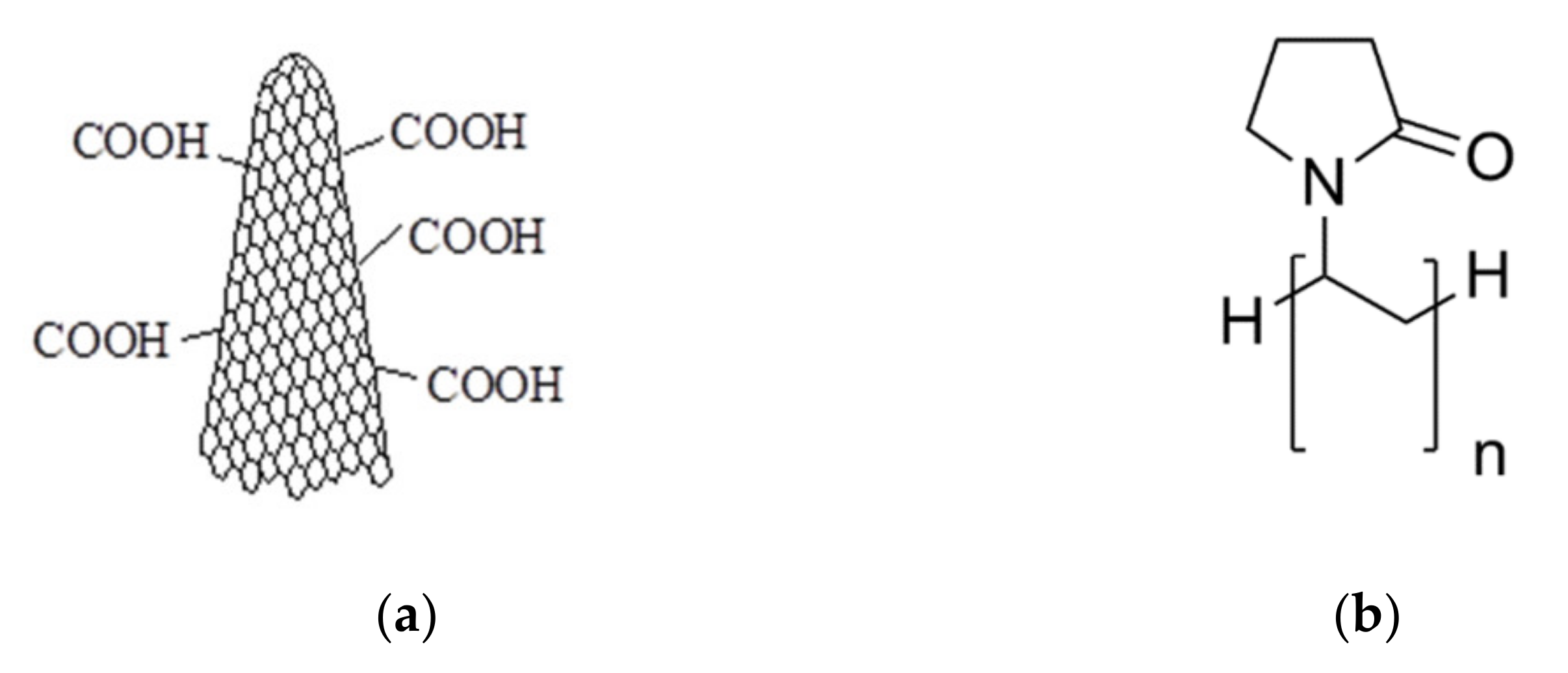

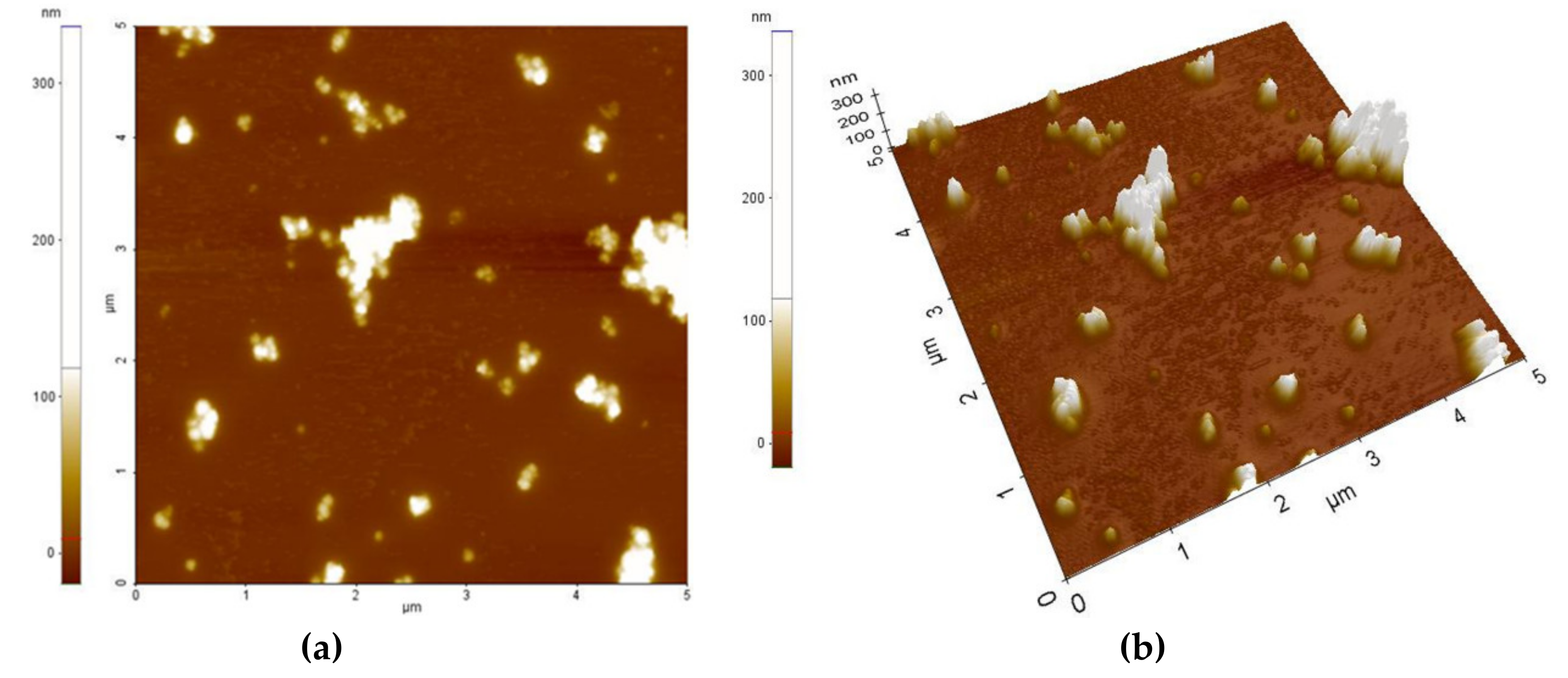
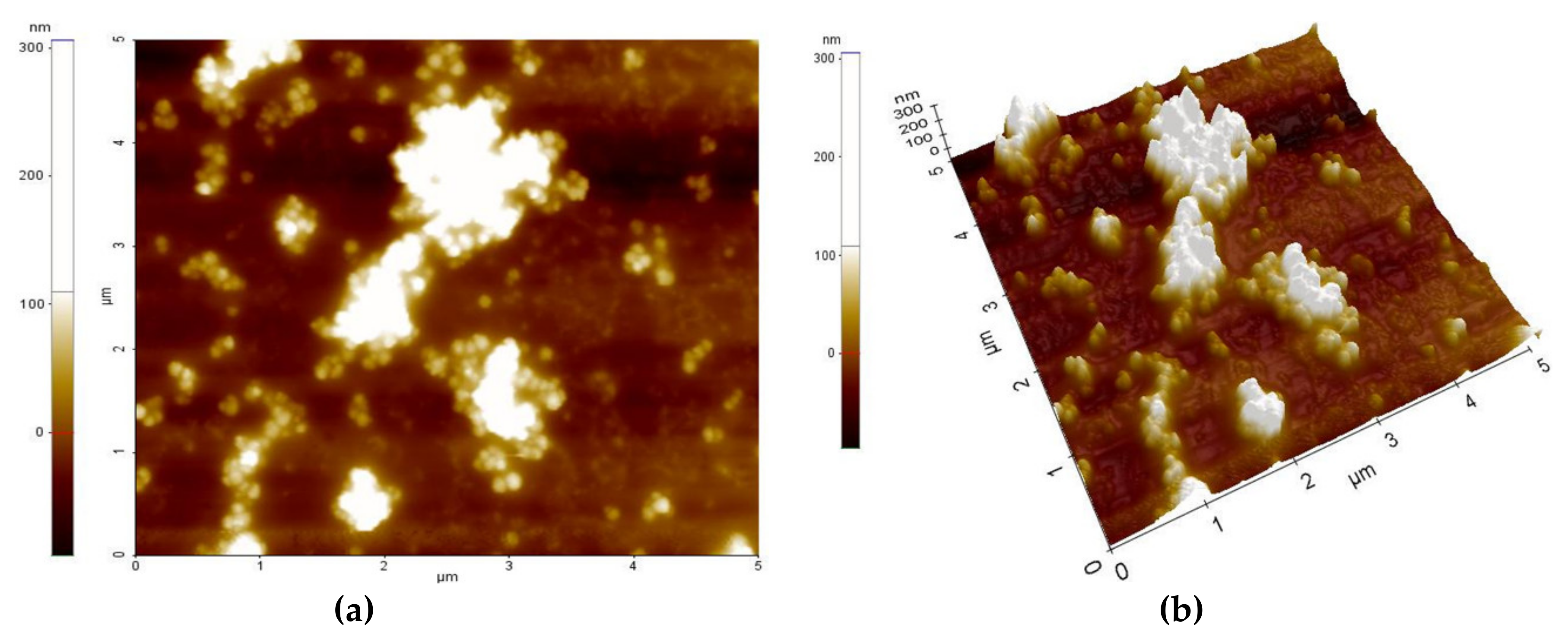

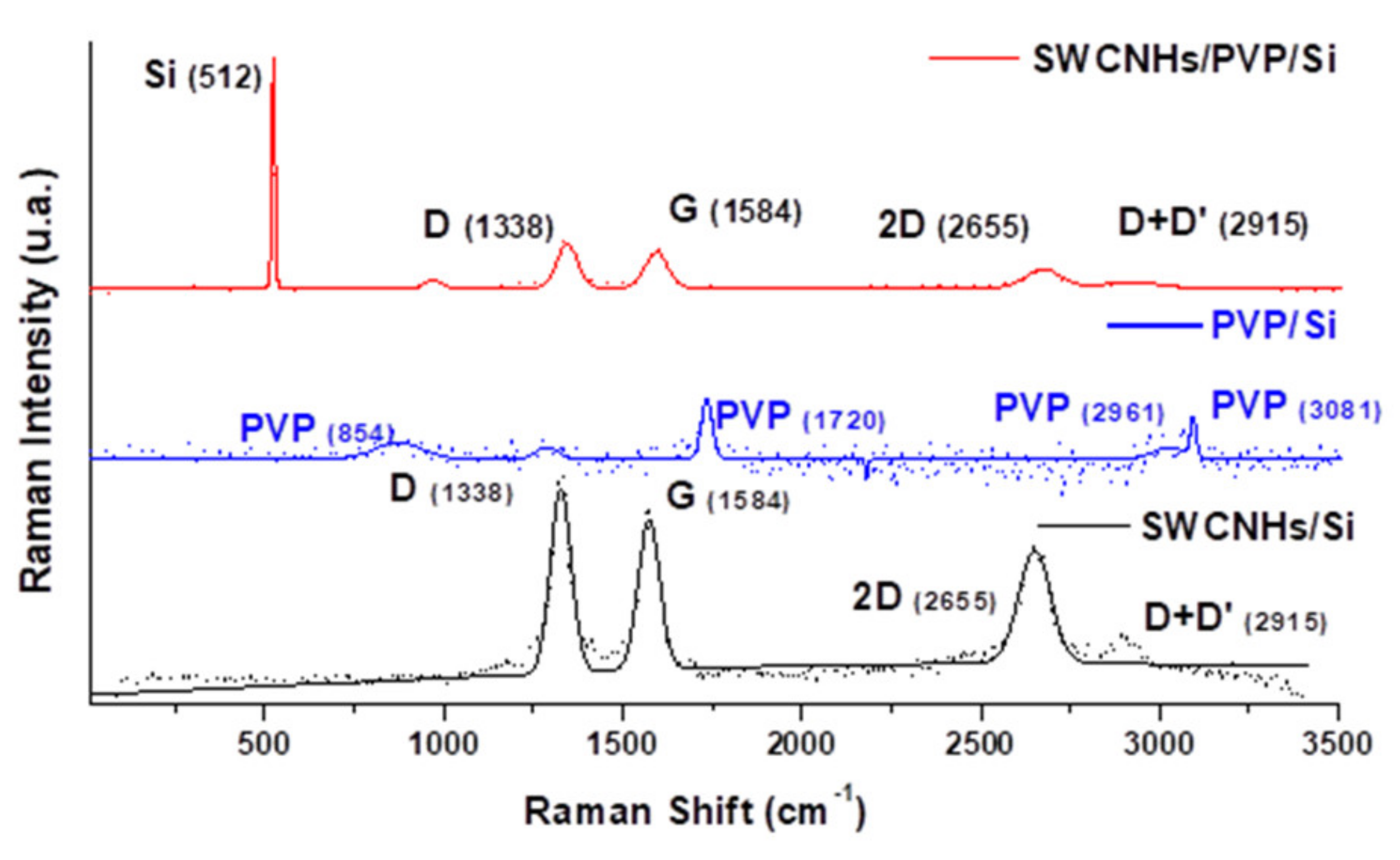


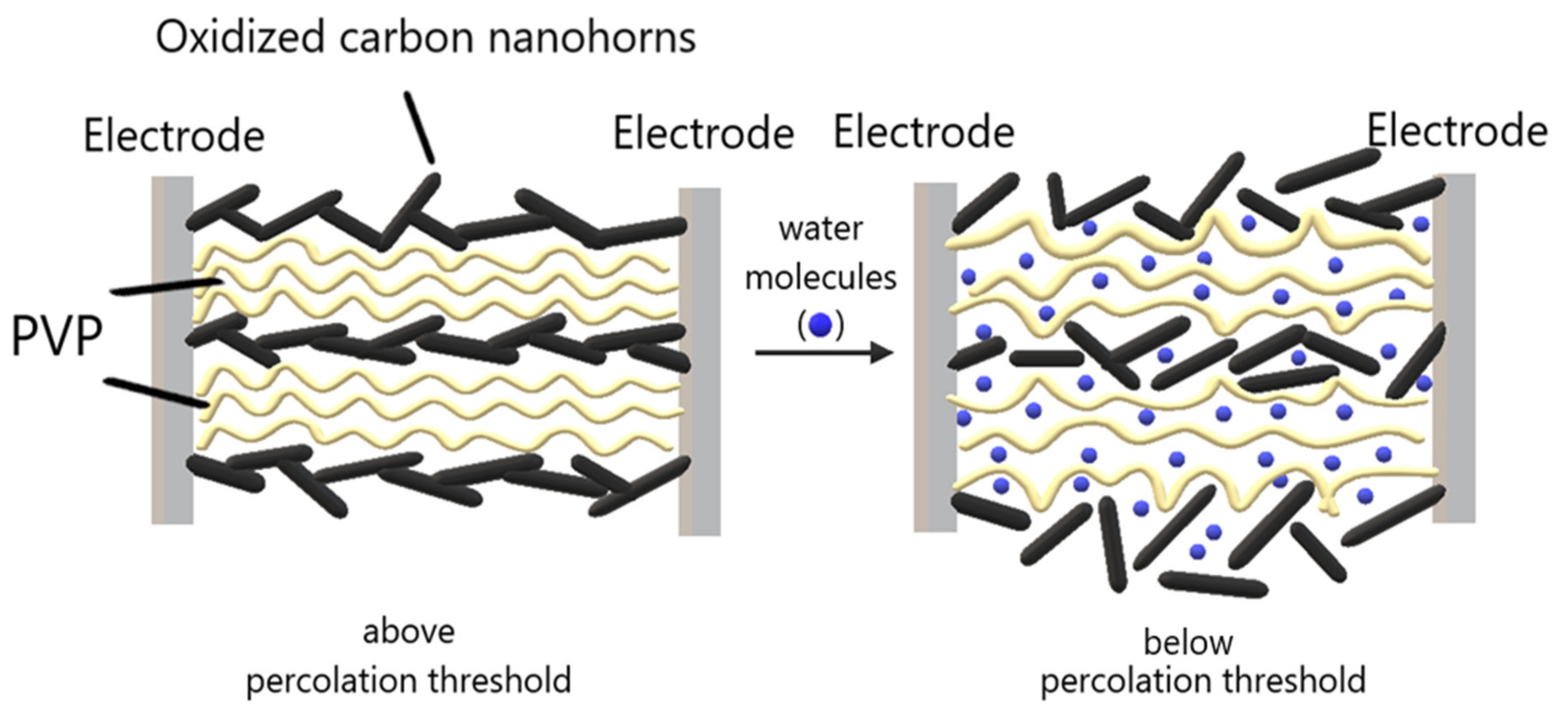
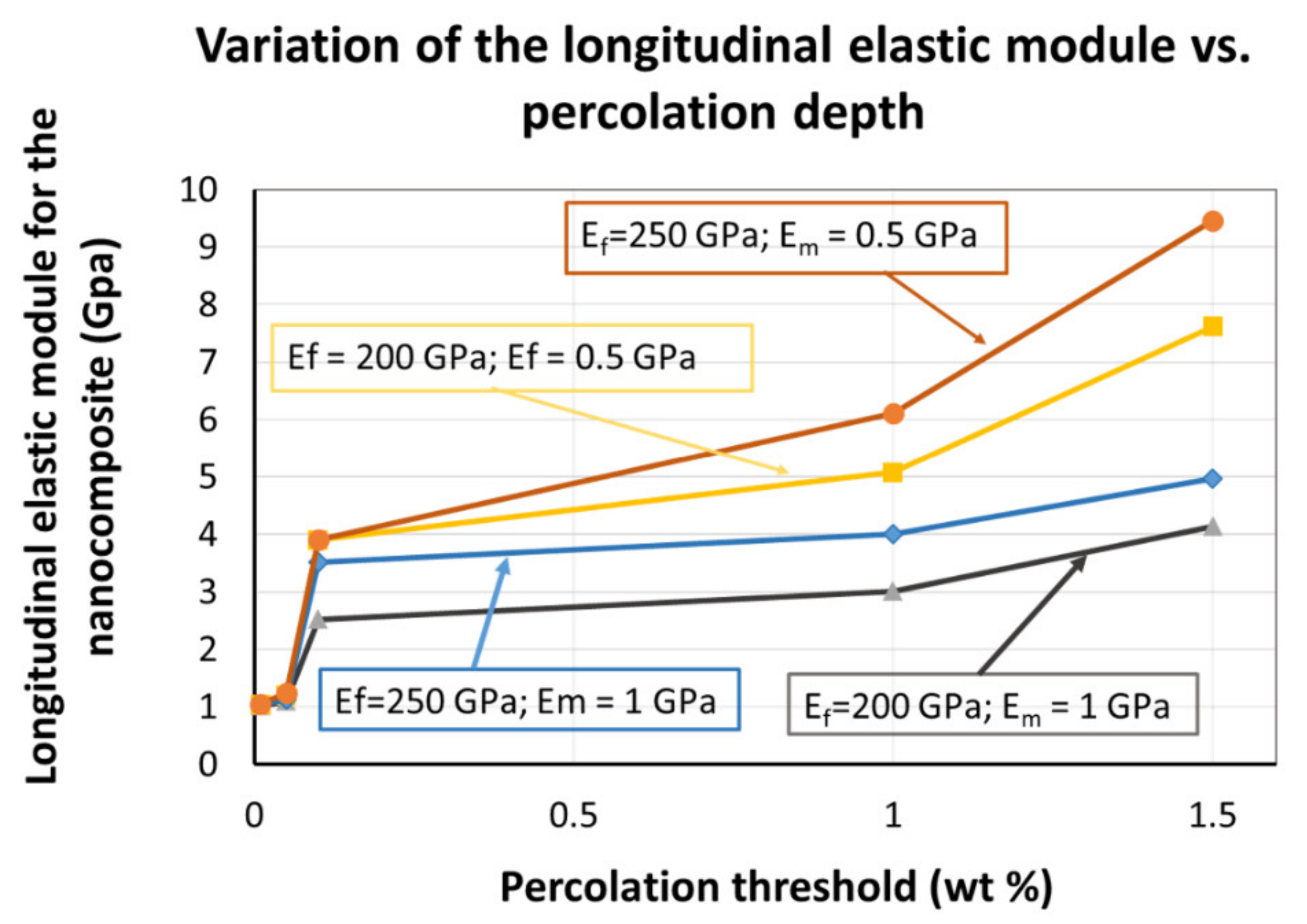
| Conductive Carbonic Filler | Inert Polymeric Matrix | Synthesis Method | Percolation Threshold (wt%) | Reference |
|---|---|---|---|---|
| SWCNT | Epoxy | Dispersion (sonicated, heat sheared) | 0.05 | [44] |
| Large-area reduced graphene oxide (LrGO) | Polyvinyl alcohol (PVA) | Dispersion (stirred at 98 °C for 30 min) | 0.189 | [45] |
| Carbon nanotubes | High-density polyethylene | Melt processing technique | 4 | [46] |
| MWCNT | Polystyrene latex | Dispersion in water (sonication for 30 min at room temperature) | 4 | [47] |
| MWCNT | PVC | Dispersion (stirred, grinded, hot-pressed) | 0.094 | [48] |
| MWCNT | P3HT/PMMA | Dispersion in trifluoroacetic acid/tetrahydrofurane (sonicated) | 0.006 | [49] |
| MWCNT | PET | Coagulation method | 0.9 | [50] |
| MWCNT | PS-latex | Dispersion in water, sonicated | 0.36 | [51] |
| Thermally reduced graphene oxide | High-density polyethylene- polypropylene | Melt compounding method | 3 | [52] |
| Surfactant exfoliated graphene | High-density polyethylene- polypropylene | Melt compounding method | 7 | [52] |
Publisher’s Note: MDPI stays neutral with regard to jurisdictional claims in published maps and institutional affiliations. |
© 2021 by the authors. Licensee MDPI, Basel, Switzerland. This article is an open access article distributed under the terms and conditions of the Creative Commons Attribution (CC BY) license (http://creativecommons.org/licenses/by/4.0/).
Share and Cite
Serban, B.-C.; Cobianu, C.; Dumbravescu, N.; Buiu, O.; Bumbac, M.; Nicolescu, C.M.; Cobianu, C.; Brezeanu, M.; Pachiu, C.; Serbanescu, M. Electrical Percolation Threshold and Size Effects in Polyvinylpyrrolidone-Oxidized Single-Wall Carbon Nanohorn Nanocomposite: The Impact for Relative Humidity Resistive Sensors Design. Sensors 2021, 21, 1435. https://doi.org/10.3390/s21041435
Serban B-C, Cobianu C, Dumbravescu N, Buiu O, Bumbac M, Nicolescu CM, Cobianu C, Brezeanu M, Pachiu C, Serbanescu M. Electrical Percolation Threshold and Size Effects in Polyvinylpyrrolidone-Oxidized Single-Wall Carbon Nanohorn Nanocomposite: The Impact for Relative Humidity Resistive Sensors Design. Sensors. 2021; 21(4):1435. https://doi.org/10.3390/s21041435
Chicago/Turabian StyleSerban, Bogdan-Catalin, Cornel Cobianu, Niculae Dumbravescu, Octavian Buiu, Marius Bumbac, Cristina Mihaela Nicolescu, Cosmin Cobianu, Mihai Brezeanu, Cristina Pachiu, and Matei Serbanescu. 2021. "Electrical Percolation Threshold and Size Effects in Polyvinylpyrrolidone-Oxidized Single-Wall Carbon Nanohorn Nanocomposite: The Impact for Relative Humidity Resistive Sensors Design" Sensors 21, no. 4: 1435. https://doi.org/10.3390/s21041435







